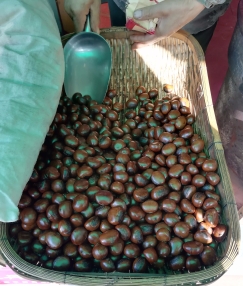
No two chestnuts crack the same way. Let that be my motto for the week.
A distinctive winter feature here is the roasting of chestnuts, often accompanied by the (loud) cries of vendors. Most communities have a shop selling fruit and vegetables with one corner devoted to jars and baskets of assorted nuts and seeds. The chestnuts are roasted in a large round steel barrel and sold usually by the half kilo. That’s how much I bought, costing me about two pounds sterling.
According to the EAT-Lancet Commission the recommended intake of nuts per day is 50g, which amounts to a couple of handfuls. I certainly wasn’t going to eat half a kilo of chestnuts in one day (the shelling alone would have tipped me over the edge) but then I suddenly had a thought: what if these are actually not classified as nuts, in the same way as almonds are technically seeds and peanuts legumes?
Yes. They are nuts. As nutty as a Nuthatch hatching nuttin’ but nuts. And they are good for you too, a healthy source of carbohydrates and various essential minerals. In the end I prepared about 250g, along the way developing the aforementioned motto. Why. Don’t. They. Crack. Luckily they did before I did.
Tis the season of pumpkins and squashes so it made sense to me to combine the elements. First thing I made was a soup, the squash roasted with chilli and coriander seeeds and then cooked down with the chopped nuts in bay-infused stock until reduced enough to blend. A palmful of lemon thyme leaves stirred in at the end lifted the dish. It was good enough and warming, the spices and herbs combatting the natural sweetness of the main ingredients.
Somehow it didn’t quite hit the spot though. I wanted something more robust and hearty. I took inspiration from Italian cuisine, especially the famous Ferrarese dish cappellacci di zucca, which uses pumpkin puree as a filling for ravioli.
So I made a puree of my own by roasting squash pieces with salt, pepper, a little chilli powder and sprigs of lemon thyme. Once these were ready, about twelve minutes in a hot oven, I put them in a pan with enough vegetable stock to cover and reduced the mixture until it had conglomerated enough to be able to combine with an electric hand mixer. Result: nice silky smooth puree.
Meanwhile I shelled the nuts – about 50g or so – and then grated them into a bowl. Rooting around in my cupboards I came across some dried porcini mushrooms. Time to turn up late Autumn factor to eleven. These I soaked in warm water for about thirty minutes (note somewhat staggered timing here; I was making it up as I went. Obviously if I had found the mushrooms earlier I would already have put them to soak). I cooked up some conchiglie, not due to any aesthetic reasons but because it was the only pasta I had. Anyway, I figured, the natural cups made by the shell shape would hold the sauce I made quite nicely.
With the pasta almost ready I chopped up the mushrooms and fried them with a little oil, garlic and some of the soaking liquor (again, hindsight allowed me to reckon that the squash stock could have been augmented with the mushroom liquid, if only I’d thought of that. If only). Anyway I heated up the puree and tipped the cooked pasta into it, stirring until thoroughly combined. On went the mushrooms, then the grated chestnuts. I finished with dots of goat’s cheese, which turned out to be a surprising salty necessity.

Great flavours – at once sweet and earthy, rich and tangy. Texturally not too bad either, although as I was eating it I figured the ingredients might all work better together in a lasagne of sorts. Waiting on a mushroom delivery. Watch this space.












